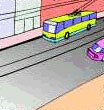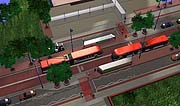 |
What is a Trolleybus? |
| Chris Veasey tries to explain | |
 |
What is a Trolleybus? |
| Chris Veasey tries to explain | |
![]()
The fundamental difference between trams and trolleybuses is that trams have flanged wheels and run on
rails like a train [whether on reserved track like most railways or in streets on grooved track installed flush with
the road surface]; whereas trolleybuses have conventional rubber tyres for ordinary road surface and are essentially
electrically powered buses.
 Trolleybuses take their electric power from a pair of parallel overhead wires by means of a pair of booms fitted to
the top of the vehicle. Trams normally take their power from a single, thicker overhead wire suspended from a catenary
wire, by means of a pantograph fitted to the top of the vehicle.
Trolleybuses take their electric power from a pair of parallel overhead wires by means of a pair of booms fitted to
the top of the vehicle. Trams normally take their power from a single, thicker overhead wire suspended from a catenary
wire, by means of a pantograph fitted to the top of the vehicle.
The reason trams only use a single electric contact wire is that they use the running rails for the electrical return
to complete the electric circuit to provide the power. Trolleybuses, having no rails, and indeed being insulated by
the rubber tyres, need the second overhead wire to provide the electrical return and complete the circuit.
 Trams are normally electrically powered but don't have to be, and indeed the earliest passenger tramways in the 19th
century were horse-drawn and later steam powered, until replacement by electric power at the end of the 19th century,
when the real boom in street tramways started in cities and towns in Britain and elsewhere.
Trams are normally electrically powered but don't have to be, and indeed the earliest passenger tramways in the 19th
century were horse-drawn and later steam powered, until replacement by electric power at the end of the 19th century,
when the real boom in street tramways started in cities and towns in Britain and elsewhere.
Some early electric tramways didn't use overhead wires, but took power from a line of metal 'studs' in the road
surface connected by electric cable buried in the road. This had disadvantages which were occasional electric shocks to
unwary people or horses, and damage to other buried pipes and cables through stray electric currents leaking through the
subsoil.
The need for expensive track replacement, or repair, through neglect in the war years together with the replacement
costs for new trams lead to the rapid decline of tramway systems during the early 1930s with their replacement by
cheaper and more flexible buses or trolleybuses. The investment in the undertakings tramway traction electrical supply
systems remained viable in many British cities for replacement trolleybus and this factor created a booming
market for these vehicles throughout the 1930s and 1940s.
There were a few new trolleybus routes or extensions built right up until the early 1960s but by then most trolley
vehicles were in need of replacement. The limited market for UK trolleybuses saw an unhealthy price differential with
diesel buses and this swayed many operators to close their trolleybus networks.
London had by far the biggest trolleybus network in Britain, including the 607 route along Uxbridge Road which replaced the
original tram route, and which many present or former Ealing residents remember with affection. London's trolleybus
network had all gone by the early 1960s being replaced by diesel buses.
Trolleybuses have advantages over trams in that they can steer round obstructions such as parked vehicles or accident
scenes, or in emergency swerve to avoid an accident themselves, within reason. The electricity pickup booms swivel so
the trolleybus can deviate from the course of the wires. They can also be fitted with auxiliary power, such as a battery,
so that they can go 'offline' away from the route of the wires if need - for example this could be done in instances
such as the IRA bomb incident in Ealing Broadway last year.
Trams on the other hand are confined to their fixed track, and are stuck in the event of a blockage of the line for
whatever reason. This is being represented by proponents of the proposed Uxbridge Road tramway scheme as an advantage
of trams in that this dictates that other traffic has to be removed from the road, or is deterred from obstructive
behaviour by the knowledge that they'll be blocking the tramline. [This did not stop the previous generation of trams
being obstructed by other road users, however, nor the new trams in places such as Manchester, Sheffield and Croydon
where the tramway runs on the streets].
 In any case trolleybus routes can be given priority by means of bus lanes, or even concrete guided bus ways [such as
have been introduced on some parts of bus routes in Ipswich, Leeds, Bradford etc] where road space permits, but this
can be dispensed with where there really isn't space to provide an exclusive right of way for the trolleybus without
swamping other, local roads with displaced traffic [as would be the case in Ealing and all the other town centres along
the route of the proposed Uxbridge Road tramway].
In any case trolleybus routes can be given priority by means of bus lanes, or even concrete guided bus ways [such as
have been introduced on some parts of bus routes in Ipswich, Leeds, Bradford etc] where road space permits, but this
can be dispensed with where there really isn't space to provide an exclusive right of way for the trolleybus without
swamping other, local roads with displaced traffic [as would be the case in Ealing and all the other town centres along
the route of the proposed Uxbridge Road tramway].
The other disadvantage of trams is the high cost,
construction time and disruption which installing tram lines on the
road involves. Modern street tramways necessitate all the mass of underground pipes and cables [gas, water, electricity,
telecom etc] to be relocated away from the route of a street tramway, so that the tram route is not forever blocked by
these other 'statutory undertaker' companies digging up the road to get and repair their pipes or cables. This takes a
long time and costs a fortune even before the tram track can be laid, which itself is very expensive. A trolleybus
route can be installed for a fraction of the cost and construction time of a street tramway. Thus we could get a lot
more trolleybus route [indeed a proper network] for the price of a single tram route, and get it a lot quicker.
For any more information then visit the website of the Electric TBus Group
[www.tbus.org.uk] which contains a mine of information, technical and otherwise.
The TBus group is a voluntary pressure group advocating introduction of modern trolleybus systems on suitable corridors,
particularly in London. There is no shortage of pro-tram groups and websites to be found using a search engine.
Ealing Council is currently working with Transport for London [TfL] to work up and implement a street tramway along
Uxbridge Road, despite the problems this will cause. Alex Williams is the senior Council officer involved in this,
working with a team of transport for London officers and consultants in Perceval House headed by Tim Jones. Local
resident's pressure groups led by Save Ealing's Streets are strongly opposing this tram scheme, because of the
problems including displacement of other Uxbridge Road traffic into residential streets, and the poor public
consultation before the Mayor for London made the decision to go ahead.